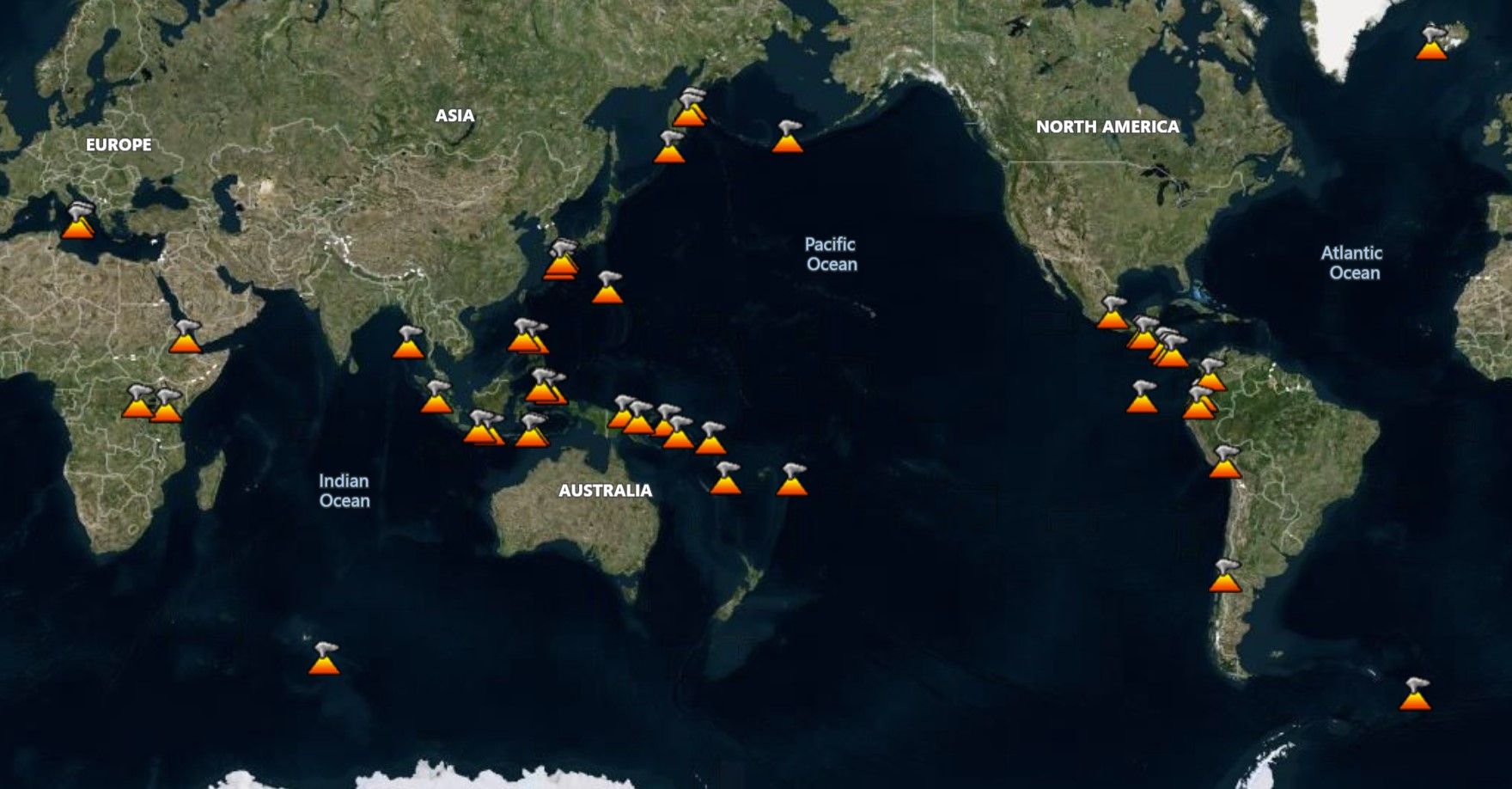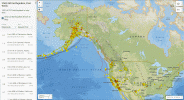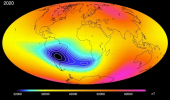You are using an out of date browser. It may not display this or other websites correctly.
You should upgrade or use an alternative browser.
You should upgrade or use an alternative browser.
Earthquakes around the world
- Thread starter pescado
- Start date
M 5.8 - South Sandwich Islands region
Time: 2021-08-18 02:48:56 (UTC)Location: 59.699°S 26.134°W
Depth: 38.5 km
Strong mag. 6.9 earthquake - Coral Sea, Vanuatu
Date & time: 18 Aug 2021 10:10:04 UTC - 1 hour 44 minutes agoLocal time at epicenter: Wednesday, 18 Aug 2021 9:10 pm (GMT +11)
Magnitude: 6.9
Depth: 89.5 km
Epicenter latitude / longitude: 14.8584°S / 167.1048°E

Antipode: 14.8584°N / 12.8952°W --> Check quakes!
Nearest volcano: Gaua (94 km / 58 mi)
During the past 24 hours, there were 11 quakes of magnitude 5.0 or above, 31 quakes between 4.0 and 5.0, 91 quakes between 3.0 and 4.0, and 238 quakes between 2.0 and 3.0. There were also 393 quakes below magnitude 2.0 which people don't normally feel.
Biggest quake today: 5.9 quake South Atlantic Ocean, South Georgia & South Sandwich Islands, 18 Aug 2021 7:49 pm (GMT -2) 18 hours ago
Most recent quake: 2.6 quake Aegean Sea, 61 km south of Kos, Dodecanese, South Aegean, Greece, 19 Aug 2021 6:52 pm (GMT +3) 21 minutes ago
Earthquakes Today: latest quakes worldwide past 24 hours, Thursday, 19 Aug 2021 - complete list and interactive map
Biggest quake today: 5.9 quake South Atlantic Ocean, South Georgia & South Sandwich Islands, 18 Aug 2021 7:49 pm (GMT -2) 18 hours ago
Most recent quake: 2.6 quake Aegean Sea, 61 km south of Kos, Dodecanese, South Aegean, Greece, 19 Aug 2021 6:52 pm (GMT +3) 21 minutes ago
Earthquakes Today: latest quakes worldwide past 24 hours, Thursday, 19 Aug 2021 - complete list and interactive map
Does anyone have any information on Madagascar re this site. I cannot find anything about earthquake or volcano activity, yet I have NEVER seen a fully red reading. If I recall correctly, there was a lava tube collapse in that region last year. I think it was in one the C's sessions.
During the past 24 hours, there were 9 quakes of magnitude 5.0 or above, 31 quakes between 4.0 and 5.0, 122 quakes between 3.0 and 4.0, and 264 quakes between 2.0 and 3.0. There were also 520 quakes below magnitude 2.0 which people don't normally feel.
Biggest quake today: 5.5 quake South Pacific Ocean, New Zealand, 20 Aug 2021 2:04 am (GMT -12) 3 hours 48 minutes ago
Most recent quake: 3.0 quake South Pacific Ocean, 121 km northeast of Tauranga, Bay of Plenty, New Zealand, 21 Aug 2021 5:28 am (GMT +12) 24 minutes ago
Earthquakes Today: latest quakes worldwide past 24 hours, Friday, 20 Aug 2021 - complete list and interactive map
Biggest quake today: 5.5 quake South Pacific Ocean, New Zealand, 20 Aug 2021 2:04 am (GMT -12) 3 hours 48 minutes ago
Most recent quake: 3.0 quake South Pacific Ocean, 121 km northeast of Tauranga, Bay of Plenty, New Zealand, 21 Aug 2021 5:28 am (GMT +12) 24 minutes ago
Earthquakes Today: latest quakes worldwide past 24 hours, Friday, 20 Aug 2021 - complete list and interactive map
Lot's of micro quakes. But nothing FOUND of any significance at this time.Madagascar

Global Volcanism Program | Current Eruptions
There are 46 volcanoes with continuing eruptions as of the Stop Dates provided, and as reported through 11 October 2023. Although detailed statistics are not kept on daily activity, generally there are around 20 volcanoes actively erupting at any particular time. The Smithsonian / USGS Weekly...
volcano.si.edu

Quake info: Minor mag. 1.3 earthquake - 21 km east of Mamoudzou, Mayotte, on Friday, Aug 20, 2021 at 3:59 am (GMT +3)
Detailed info, map, data, reports, updates about this earthquake: Minor mag. 1.3 earthquake - 21 km east of Mamoudzou, Mayotte, on Friday, Aug 20, 2021 at 3:59 am (GMT +3) -
www.volcanodiscovery.com
Wish I had taken a screenshot. It was deep red for several hours and then late afternoon it was removed & replaced by a normal blue square with a few squiggles. I am talking about the large square marker that would define volcanic activity.Lot's of micro quakes. But nothing FOUND of any significance at this time.

Global Volcanism Program | Current Eruptions
There are 46 volcanoes with continuing eruptions as of the Stop Dates provided, and as reported through 11 October 2023. Although detailed statistics are not kept on daily activity, generally there are around 20 volcanoes actively erupting at any particular time. The Smithsonian / USGS Weekly...volcano.si.edu

Quake info: Minor mag. 1.3 earthquake - 21 km east of Mamoudzou, Mayotte, on Friday, Aug 20, 2021 at 3:59 am (GMT +3)
Detailed info, map, data, reports, updates about this earthquake: Minor mag. 1.3 earthquake - 21 km east of Mamoudzou, Mayotte, on Friday, Aug 20, 2021 at 3:59 am (GMT +3) -www.volcanodiscovery.com
Don't know what happened but, like I said, they never go beyond deep orange, signifying and eruption. Oh, well...
During the past 24 hours, there were 3 quakes of magnitude 5.0 or above, 42 quakes between 4.0 and 5.0, 118 quakes between 3.0 and 4.0, and 229 quakes between 2.0 and 3.0. There were also 424 quakes below magnitude 2.0 which people don't normally feel.
Biggest quake today: 5.0 quake South Pacific Ocean, New Zealand, 21 Aug 2021 11:59 am (GMT +12) 18 hours ago
Most recent quake: 2.3 quake South Pacific Ocean, 123 km northeast of Tauranga, Bay of Plenty, New Zealand, 22 Aug 2021 6:02 am (GMT +12) 8 minutes ago
Earthquakes Today: latest quakes worldwide past 24 hours, Saturday, 21 Aug 2021 - complete list and interactive map
Biggest quake today: 5.0 quake South Pacific Ocean, New Zealand, 21 Aug 2021 11:59 am (GMT +12) 18 hours ago
Most recent quake: 2.3 quake South Pacific Ocean, 123 km northeast of Tauranga, Bay of Plenty, New Zealand, 22 Aug 2021 6:02 am (GMT +12) 8 minutes ago
Earthquakes Today: latest quakes worldwide past 24 hours, Saturday, 21 Aug 2021 - complete list and interactive map
What the heck is going on in this place?
M 6.8 - South Sandwich Islands region
Time 2021-08-21 19:45:08 (UTC-05:00)
Location 60.140°S 24.403°W
Depth10.0 km
M 6.8 - South Sandwich Islands region
Time 2021-08-21 19:45:08 (UTC-05:00)
Location 60.140°S 24.403°W
Depth10.0 km
Related probably by location:What the heck is going on in this place?
M 6.8 - South Sandwich Islands region
Time 2021-08-21 19:45:08 (UTC-05:00)
Location 60.140°S 24.403°W
Depth10.0 km
NASA Is Tracking a Vast, Growing Anomaly in Earth's Magnetic Field
NASA is actively monitoring a strange anomaly in Earth's magnetic field: a giant region of lower magnetic intensity in the skies above the planet, stretching out between South America and southwest Africa.
This vast, developing phenomenon, called the South Atlantic Anomaly, has intrigued and concerned scientists for years, and perhaps none more so than NASA researchers. The space agency's satellites and spacecraft are particularly vulnerable to the weakened magnetic field strength within the anomaly, and the resulting exposure to charged particles from the Sun.
The South Atlantic Anomaly (SAA) – likened by NASA to a 'dent' in Earth's magnetic field, or a kind of 'pothole in space' – generally doesn't affect life on Earth, but the same can't be said for orbital spacecraft (including the International Space Station), which pass directly through the anomaly as they loop around the planet at low-Earth orbit altitudes.
"The magnetic field is actually a superposition of fields from many current sources," explains geophysicist Terry Sabaka from NASA's Goddard Space Flight Centre in Greenbelt, Maryland.
The primary source is considered to be a swirling ocean of molten iron inside Earth's outer core, thousands of kilometres below the ground. The movement of that mass generates electrical currents that create Earth's magnetic field, but not necessarily uniformly, it seems.
A huge reservoir of dense rock called the African Large Low Shear Velocity Province, located about 2,900 kilometres (1,800 miles) below the African continent, disturbs the field's generation, resulting in the dramatic weakening effect – which is aided by the tilt of the planet's magnetic axis.
"The observed SAA can be also interpreted as a consequence of weakening dominance of the dipole field in the region," says NASA Goddard geophysicist and mathematician Weijia Kuang.
"More specifically, a localised field with reversed polarity grows strongly in the SAA region, thus making the field intensity very weak, weaker than that of the surrounding regions."
While there's much scientists still don't fully understand about the anomaly and its implications, new insights are continually shedding light on this strange phenomenon.
For example, one study led by NASA heliophysicist Ashley Greeley in 2016 revealed the SAA is drifting slowly in a north-westerly direction.
It's not just moving, however. Even more remarkably, the phenomenon seems to be in the process of splitting in two, with researchers this year discovering that the SAA appears to be dividing into two distinct cells, each representing a separate centre of minimum magnetic intensity within the greater anomaly.
Just what that means for the future of the SAA remains unknown, but in any case, there's evidence to suggest that the anomaly is not a new appearance.
A study published last month suggested the phenomenon is not a freak event of recent times, but a recurrent magnetic event that may have affected Earth since as far back as 11 million years ago.
If so, that could signal that the South Atlantic Anomaly is not a trigger or precursor to the entire planet's magnetic field flipping, which is something that actually happens, if not for hundreds of thousands of years at a time.
Obviously, huge questions remain, but with so much going on with this vast magnetic oddity, it's good to know the world's most powerful space agency is watching it as closely as they are.
"Even though the SAA is slow-moving, it is going through some change in morphology, so it's also important that we keep observing it by having continued missions," says Sabaka.
"Because that's what helps us make models and predictions."
Attachments
Unreported 6.3on the Mid Atlantic Ridge.
Port Au Prince still vibrating.
 ayiti.unice.fr
ayiti.unice.fr
7.1 Downgrade to 6.9 South Sandwich Islands region 8/21/2021
Port Au Prince still vibrating.
Ayiti-SEISMES
7.1 Downgrade to 6.9 South Sandwich Islands region 8/21/2021
Last edited:
Last week continued with a lot of activity. There were 4 M6 (1 M6.9 in Vanuatu and in the South Sandwich Islands 1 M6.9, 1 M6.8 and 1 M6.1)Last week saw a flurry of big earthquakes as reported by others above, the biggest being a M8.1 in the South Sandwich Islands (South Atlantic Ocean). Apart from this there were also 3 M7 (S. Sandwich Isl., Philippines and Haiti) and 4 M6.
In the usual area, there was 1 (M6.9 in Alaska) out of 213 earthquakes worldwide equal to or greater than 4.5 and 1776 out of 2476 quakes of all sizes.
Percentage: 71.7%
In the usual area, there were 2 out of 119 earthquakes worldwide equal to or greater than 4.5 and 1851 out of 2313 quakes of all sizes.
Percentage: 80.0%

M 5.8 - South Sandwich Islands region
Time: 2021-08-22 17:21:58 (UTC+02:00)Location: 58.270°S 25.035°W
Depth: 16.2 km


